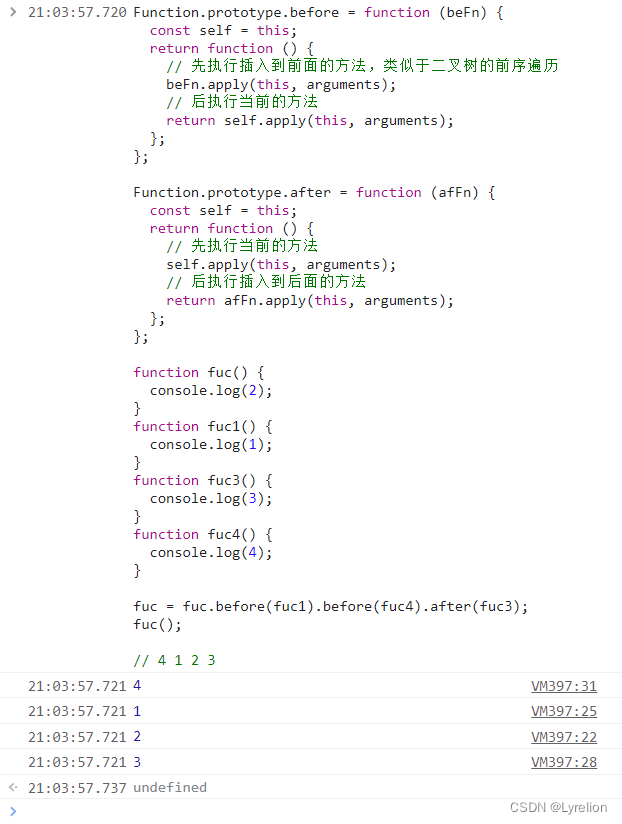目录
设计模式(Design Pattern)是从许多优秀的软件系统中,总结出的成功的、能够实现可维护的、复用的设计方案,使用这些方案 可以避免开发者做一些重复性工作
1. 单例模式
一个类只能构造出唯一实例
应用案例:弹框
class Single {
constructor(name) {
this.name = name;
}
static getInstance(name) {
// 静态方法
if (!this.instance) {
// 关键代码 this指向的是Single这个构造函数
this.instance = new Single(name);
}
return this.instance;
}
}
const single111 = Single.getInstance('name111');
const single222 = Single.getInstance('name222');
console.log(single111 === single222); // true
2. 策略模式
根据不同参数命中不同的策略
应用案例:表单验证
// 策略对象
const strategies = {
// 验证是否为空
isNoEmpty(value, errorMsg) {
if (value.trim() === '') {
return errorMsg;
}
},
// 验证最小长度
minLength(value, length, errorMsg) {
if (value.trim().length < length) {
return errorMsg;
}
},
// 验证最大长度
maxLength(value, length, errorMsg) {
if (value.length > length) {
return errorMsg;
}
},
// 验证手机号
isMobile(value, errorMsg) {
if (!/^(13[0-9]|14[5|7]|15[0|1|2|3|5|6|7|8|9]|17[7]|18[0|1|2|3|5|6|7|8|9])\d{8}$/.test(value)) {
return errorMsg;
}
},
};
// 验证类
class Validator {
constructor() {
// 存储要验证的方法
this.cache = [];
// 存储最终的验证结果
this.errList = [];
}
/**
* 添加 表单项 验证规则
* @param value 表单项值
* @param rules 验证规则数组
*/
add(value, rules) {
for (let i = 0, rule; (rule = rules[i++]);) {
/*
* 将形如 strategy: 'minLength:6', 的分割为数组
* 获取校验规则、数量
*/
const strategyAry = rule.strategy.split(':');
// 校验失败后的提示信息
const { errorMsg } = rule;
this.cache.push(() => {
// 获取校验规则,形如 minLength
const strategy = strategyAry.shift();
// 新增表单值,形如 L
strategyAry.unshift(value);
// 新增报错信息
strategyAry.push(errorMsg);
// 执行策略对象中的不同验证规则
const error = strategies[strategy](...strategyAry);
// 如果没通过校验,就不断填充报错信息列表s
if (error) {
this.errList.push(error);
}
});
}
}
start() {
for (let i = 0, validatorFunc; (validatorFunc = this.cache[i++]);) {
validatorFunc();
}
return this.errList;
}
}
const validataFunc = function (formData) {
// 实例化验证类
const validator = new Validator();
// 配置 用户名 验证规则
validator.add(formData.userName, [
{
strategy: 'isNoEmpty',
errorMsg: '用户名不可为空',
},
{
strategy: 'minLength:2',
errorMsg: '用户名长度不能小于2位',
},
]);
// 配置 密码 验证规则
validator.add(formData.mima, [
{
strategy: 'minLength:6',
errorMsg: '密码长度不能小于6位',
},
]);
// 配置 手机号码 验证规则
validator.add(formData.phoneNumber, [
{
strategy: 'isMobile',
errorMsg: '请输入正确的手机号码格式',
},
]);
// 开始校验
return validator.start();
};
// 需要验证的表单对象
const TEST_USERINFOS = {
userName: 'L',
mima: '1',
phoneNumber: '123456',
};
const result = validataFunc(TEST_USERINFOS);
console.log(result); // ['用户名长度不能小于2位', '密码长度不能小于6位', '请输入正确的手机号码格式']
3. 代理模式
代理对象和本体对象具有一致的接口
应用案例:图片预加载
// 本体图片
const relImage = (function () {
const imageDOM = document.createElement('img');
document.body.appendChild(imageDOM);
return {
setSrc(src) {
imageDOM.src = src;
},
};
}());
// 代理图片
const proxyImage = (function () {
const img = new Image();
// 实际要加载的图片 加载成功后 替换调占位图
img.onload = function () {
relImage.setSrc(img.src);
};
return {
setSrc(src) {
img.src = src;
// 设置占位图
relImage.setSrc('https://fuss10.elemecdn.com/e/5d/4a731a90594a4af544c0c25941171jpeg.jpeg');
},
};
}());
// 设置实际要加载的图片
proxyImage.setSrc('https://cube.elemecdn.com/6/94/4d3ea53c084bad6931a56d5158a48jpeg.jpeg');
4. 装饰者模式
在不改变对象自身的基础上,动态地给某个对象添加一些额外的职责
应用案例:在函数执行前后添加新的方法
Function.prototype.before = function (beFn) {
const self = this;
return function () {
// 先执行插入到前面的方法,类似于二叉树的前序遍历
beFn.apply(this, arguments);
// 后执行当前的方法
return self.apply(this, arguments);
};
};
Function.prototype.after = function (afFn) {
const self = this;
return function () {
// 先执行当前的方法
self.apply(this, arguments);
// 后执行插入到后面的方法
return afFn.apply(this, arguments);
};
};
function fuc() {
console.log(2);
}
function fuc1() {
console.log(1);
}
function fuc3() {
console.log(3);
}
function fuc4() {
console.log(4);
}
fuc = fuc.before(fuc1).before(fuc4).after(fuc3);
fuc(); // 4 1 2 35. 组合模式
组合模式在对象间形成树形结构
- 组合模式中,基本对象 和 组合对象被一致对待
- 无须关心对象有多少层, 调用时只需在根部进行调用
应用案例: 打印文件目录
class Combine {
constructor() {
this.list = [];
}
add(fn) {
this.list.push(fn);
return this; // 链式调用
}
excute() {
for (let i = 0; i < this.list.length; i++) {
this.list[i].excute();
}
}
}
const comb1 = new Combine();
comb1
.add({
excute() {
console.log(1);
},
})
.add({
excute() {
console.log(2);
},
});
const comb2 = new Combine();
comb2
.add({
excute() {
console.log(3);
},
})
.add({
excute() {
console.log(4);
},
});
const comb3 = new Combine();
comb3
.add({
excute() {
console.log(5);
},
})
.add({
excute() {
console.log(6);
},
});
comb2.add(comb3);
const comb4 = new Combine();
comb4.add(comb1).add(comb2);
comb4.excute(); // 1 2 3 4 5 6
6. 工厂模式
工厂模式是用来创建对象的,将 “创建对象的具体逻辑” 封装在一个函数中,这个函数就可以被视为一个工厂
应用案例: jquery 中的 window.$
class Car {
constructor(name, color) {
this.name = name;
this.color = color;
}
}
class Factory {
static create(type) {
switch (type) {
case 'car':
return new Car('汽车', '白色');
break;
case 'bicycle':
return new Car('自行车', '黑色');
break;
default:
console.log('没有该类型');
}
}
}
let p1 = Factory.create('car');
let p2 = Factory.create('bicycle');
console.log(p1, p1 instanceof Car); // { name: '汽车', color: '白色' } true
console.log(p2, p2 instanceof Car); // { name: '自行车', color: '黑色' } true
7. 访问者模式
在不改变该对象的前提下,访问其结构中元素的新方法
应用案例:babel 插件
// 元素类
class Student {
constructor(name, chinese, math, english) {
this.name = name;
this.chinese = chinese;
this.math = math;
this.english = english;
}
accept(visitor) {
visitor.visit(this);
}
}
// 访问者类
class ChineseTeacher {
visit(student) {
console.log(`语文${student.chinese}`);
}
}
class MathTeacher {
visit(student) {
console.log(`数学${student.math}`);
}
}
class EnglishTeacher {
visit(student) {
console.log(`英语${student.english}`);
}
}
// 实例化元素类
const student = new Student('张三', 138, 150, 146);
// 实例化访问者类
const chineseTeacher = new ChineseTeacher();
const mathTeacher = new MathTeacher();
const englishTeacher = new EnglishTeacher();
// 接受访问
student.accept(chineseTeacher); // 语文 138
student.accept(mathTeacher); // 数学 150
student.accept(englishTeacher); // 英语 146
8. 发布订阅模式
订阅者订阅相关主题,发布者通过发布主题事件的方式,通知订阅该主题的对象
应用案例:EventBus
// 发布订阅模式
class EventBus {
constructor() {
this.task = {};
}
on(type, fn) {
// on 注册事件
if (!this.task[type]) this.task[type] = [];
this.task[type].push(fn);
}
emit(type, ...args) {
// emit 发送事件
if (this.task[type]) {
this.task[type].forEach(fn => {
fn.apply(this, args); // 注意this指向
});
}
}
off(type, fn) {
// 删除事件
if (this.task[type]) {
this.task[type] = this.task[type].filter(item => item !== fn);
}
}
once(type, fn) {
// 只执行一次
function f(...args) {
fn(...args);
this.off(type, f);
}
this.on(type, f);
}
}
// 测试
let event = new EventBus();
event.on("change", (...args) => {
console.log(args);
});
// 只执行一次
event.once("change", (...args) => {
console.log(args);
});
event.emit("change", 1, 2);
event.emit("change", 2, 3);
9. 观察者模式
一个对象有一系列依赖于它的观察者(watcher),当对象发生变化时,会通知观察者进行更新
应用案例: vue 双向绑定
const data = {
name: 'ming',
age: 18,
};
Object.keys(data).forEach((key) => {
let value = data[key];
Object.defineProperty(data, key, {
get() {
console.log('get', value);
return value;
},
set(newValue) {
console.log('更新');
value = newValue;
},
});
});
data.name = '佩奇';
console.log(data.name); // 更新 → get 佩奇 → 佩奇
观察者模式 VS 发布订阅模式
观察者模式:一个对象有一系列依赖于它的观察者(watcher),当对象发生变化时,会通知观察者进行更新
发布订阅模式:订阅者订阅相关主题,发布者通过发布主题事件的方式,通知订阅该主题的对象,发布订阅模式中,可以基于不同的主题,去执行不同的自定义事件
